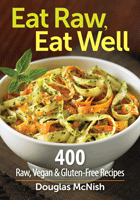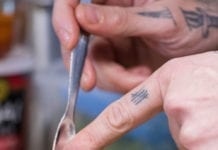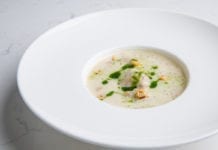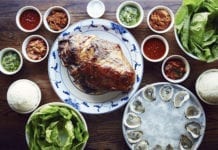In 2005 Douglas McNish was overweight, unhappy and working as a grill cook at an exclusive steakhouse in Toronto. One day someone showed him an undercover PETA video taken in a slaughterhouse; the animal suffering it depicted changed McNish’s life.
“There I was, cooking 200 to 300 steaks a night,” he says, “but I decided to go vegetarian.” Not only that, he soon went vegan, and then became a leading specialist in creating raw dishes. Along the way, he dropped 100 lbs and developed a new, positive attitude about life.
“It’s amazing how good eating raw can make you feel,” he says, “physically, mentally, emotionally — you just have a better sense of well-being.” Today, the certified Red Seal chef runs a consulting company that has helped top-tier establishments such as Toronto’s Windsor Arms Hotel and Muskoka’s Taboo Resort, introduce vegan, raw and gluten-free dishes. His first cookbook, Eat Raw, Eat Well (Robert Rose Inc.), published in May, collects 400 such recipes, offering everything from smoothies and soups to salads, burgers, pastas and desserts. We spoke to McNish about going raw, getting healthy and attracting new customers.
How would you describe your cooking philosophy?
I’m a big believer in health and nutrition, but I don’t sacrifice flavour. Because I’m classically trained, I understand the principles of fine cuisine, so my goal is to serve vegan dishes that are as good as [those at] the top restaurants in the country.
What is raw food?
Raw food is vegan, but it goes a step further because nothing is heated past 115°F. It’s been scientifically proven that if you heat food past that, it destroys the enzymes needed to digest food. Also, much of the nutrition — the vitamins, proteins and amino acids — are destroyed.
What made you want to write this book?
There was nothing like it on the market. Every raw-food title was either airy-fairy and spiritual or didn’t have enough recipes. This is a very practical book, packed with recipes. Betty and Bob from the ’burbs, who know nothing about cooking, can create every recipe in it.
While writing this book, what was the most interesting thing you learned about cooking?
The importance, for flavour, of using the highest quality organic spices available. They are sometimes overlooked but just as important as using the finest organic produce.
What’s the most surprising thing you learned about writing a cookbook?
The amount of editing required. It took eight months to write the book and four more months to edit it.
What do you hope a chef or restaurateur takes away from this book?
There’s a whole clientele out there who are very health-conscious, and if you can’t feed them in your restaurant, that’s a lost revenue stream. I hope this book will help other professionals expand their repertoire with ingredients and techniques to feed that audience.
Can you provide advice for chefs or restaurateurs writing cookbooks?
Don’t rush. Working on a cookbook is not dynamic like working in a restaurant. The work is static. You sit in front of a computer for a long time. But it’s worth taking the time, because your name is on it.
What is your favourite recipe from the book?
The chocolate walnut brownie. It has three ingredients — raw cacao, walnuts and agave — and it takes 30 seconds to make. I’ve served it to some of the most discerning palates, and they all loved it.
Keep Reading
Tim Hortons Announces Animal Welfare Initiatives
Farm to Fork: Blueprint for Change
Recipe: Seafood Tomato Alfredo





















